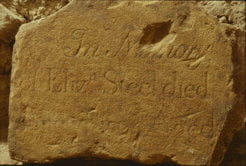In the annals of Australia’s history, there exist tales of resilience, hardship, and the pursuit of a new life amidst adversity. One such story revolves around Elizabeth Steel, also known as Betty Steel, a figure whose life journey traversed the tumultuous seas of the Second Fleet to the shores of early Australian settlements.
Born around 1766, Elizabeth Steel’s life took a fateful turn when she was convicted in 1787 for the theft of a silver watch, a charge that led to a seven-year sentence of penal transportation. For over 150 years, a grim chapter unfolded in the history of both Britain and Australia. Between 1788 and 1868, an estimated 164,000 convicts were transported from overcrowded British prisons to the penal colony of Australia. These individuals, facing harsh sentences for crimes ranging from petty theft to murder, were seen as a burden on the British justice system and a potential threat to social order.
Aboard the Lady Juliana, part of the Second Fleet, she arrived in Sydney Cove on June 3, 1790, at the age of 23 or 24, marking the advent of her poignant journey in Australia.
What distinguishes Elizabeth Steel is the historical record marking her as ‘mute by visitation of God,’ making her the earliest known deaf individual in Australian records. Her arrival, mired in the complexities of a convict’s life, brought to light the challenges faced by a person with a hearing impairment during that era.
Despite the barriers imposed by her circumstances, Steel displayed remarkable resilience. Transferred to Norfolk Island after a brief tenure in Sydney, she forged ahead, marrying fellow convict James Mackey and cultivating a successful farming venture on a leased 10-acre plot until the end of their sentences.
Following her return to Sydney in 1794, fate dealt a cruel hand as Elizabeth Steel passed away the following year, at the tender age of 29. Her final resting place at the Old Sydney Burial Ground bears testament to her life’s trials and triumphs.
In a peculiar turn of events, the echoes of Elizabeth Steel’s legacy resurfaced in 1991 during restoration works at Sydney Town Hall. Buried under the Lower Town Hall, excavations unearthed remnants of a headstone bearing an inscription marking the memory of “Eliz Steel” who passed away in 1795. While no definitive connection was established between the headstone and the discovered remains, this artifact serves as a haunting reminder of the enigmatic stories buried in Australia’s past.
Elizabeth Steel’s narrative, though brief, resonates through the corridors of time as a testament to resilience, fortitude, and the oft-overlooked diversity within historical records. Her story invites contemplation about the experiences of individuals with disabilities in the context of early Australian society, sparking a conversation about inclusivity and representation in our shared history.
As we acknowledge her existence and struggles, Elizabeth Steel’s story stands as a poignant reminder of the diverse tapestry of individuals who contributed, in myriad ways, to the fabric of Australia’s evolving identity.



